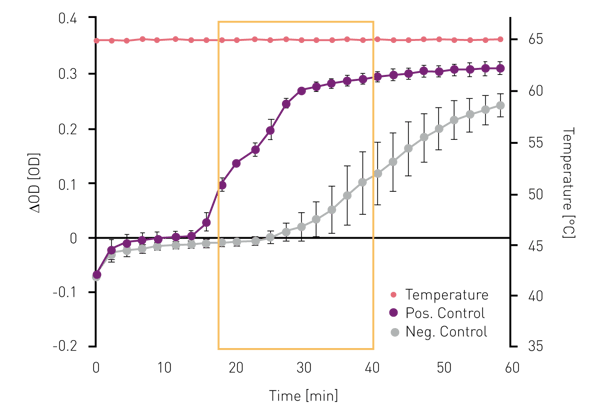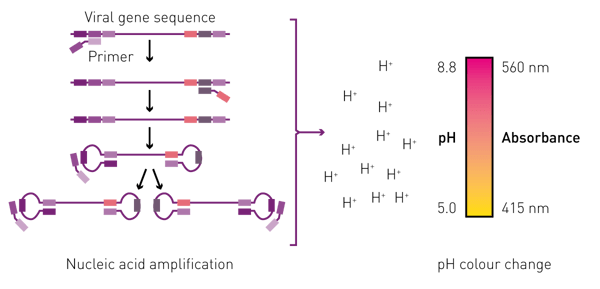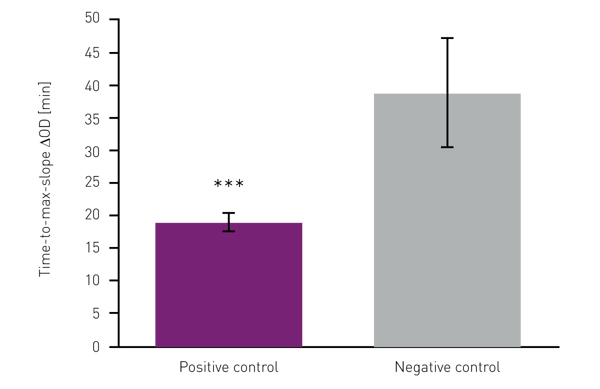Introduction
Rapid molecular diagnostic tests are a central tool to detect and thereby slow down the spread of infectious diseases. The SARS-CoV-2 pandemic has prompted international efforts to create and expand on the testing approaches available. The reverse transcription loop-mediated isothermal amplification (RT-LAMP) assay recognizes the target RNA by several distinct sequences and works to amplify it with high selectivity1. LAMP assays show comparable sensitivity and specificity to PCR based methods2. In contrast to PCR, the LAMP assay is based on a Bst polymerase instead of Taq polymerase. The Bst polymerase and its strand displacement activity work optimally at 65 °C meaning that the LAMP assay can be performed under isothermal conditions at 65 °C3. Since the need for temperature cycles is bypassed, assay runtime is reduced to about 30 min1 and the assay can be run on a plate reader with heating up to 65 °C.
The LAMP assay as a rapid diagnostic method, therefore, offers an opportunity to work in high throughput increasing diagnostic capacity as an alternative or addition to PCR techniques.
Assay Principle
In the LAMP assay, thermophilic Bst polymerase and primer sets, recognize the SARS-CoV-2 nucleic acid sequence at different positions (fig. 1). If the target nucleic acid is amplified by the LAMP assay, hydrogen ions are released, consequently shifting sample pH toward the acidic. A pH-sensitive dye is included for detection in absorbance mode. The amplification is detected as an increase in absorbance OD at 415 nm and a decrease at 560 nm of the pH-sensitive dye. In positive (pos.) samples, this pH-shift is expected to occur within 30 min from the start of the LAMP assay incubation.
Materials & Methods
- FLUOstar® Omega
- 384 well, clear bottom, sv, lobase (Greiner, #788096)
- qPCR Sealer (Greiner, #676040)
- SARS-CoV-2 Rapid Colorimetric LAMP Assay Kit incl. pos. control (NEB, #E2019S)
- RNAse-free equipment
Experimental Procedure
The FLUOstar Omega was preheated to 65 °C for 2.5 h before the LAMP assay was incubated. The pos. control included in the LAMP assay kit (n-gene) was diluted 1:10 in nuclease-free water to a concentration of 100,000 copies/µL. The colorimetric LAMP reactions were performed in a final reaction volume of 5 µL (see 4). The concentrations of the LAMP assay kit components were used according to the manufacturer’s instructions. Master mix, primers, guanidine hydrochloride, nuclease-free water, and template were premixed, transferred to a black 384 well plate, and centrifuged for 1 min at 400 g. The LAMP assay samples were measured in quadruplicate. The samples were distributed over the plate. Plates were sealed with a qPCR sealer, and then read on the FLUOstar Omega using the following settings, plate read cycle times are based on a full 384 well plate:
Instrument Settings
|
Optic settings
|
Absorbance, plate mode kinetic
|
|
|
Spectrometer
|
415 nm
560 nm |
|
|
General settings (fastest)
|
Number of flashes
|
22
|
|
Settling time
|
0.0 s
|
|
|
Kinetic settings
|
Number of cycles
|
27
|
|
Cycle time
|
133 s
|
|
|
Incubation
|
65 °C
|
|
|
Shaking
|
Double orbital, 600 rpm for 30 s before cycles 1, 6 and 11
|
|
Data analysis
The difference between absorbance at 415 nm and 560 nm (∆OD) was used to analyse the pH-sensitive colour change over the incubation time2. Time-to-maximum-slope for individual signal curves was calculated to differentiate between the pos. and negative (neg.) controls within the FLUOstar Omega MARS software.
Results & Discussion
To assess the amplification of nucleic acids, ∆OD of the pos. and neg. controls were monitored over a period of 60 min (fig. 2). A substantial increase of the ∆OD was observed for the pos. controls at about 18 min after the start of the LAMP assay. This increase of the ∆OD in the pos. control occurred comparably across the individual replicate wells and test runs. The neg. controls also displayed an increase of ∆OD, however, this change occurred later, and showed a lower slope and higher variation across wells.
 The change in ∆OD in the neg. wells is the result of spurious amplification products – a well-known event in LAMP assays. The real-time monitoring of the amplification allows to define the ideal measurement window to discriminate pos. from neg. samples (orange frame, fig. 2). To differentiate between pos. and neg. samples, time-to-maximum-slope of the individual curves can be used as an alternative way to evaluate ∆OD at a certain time point (fig. 3). While pos. controls reach max. slope after about 19 min, neg. control samples need about 39 min. This measurement can be applied using the MARS software supplied with the instrument.
The change in ∆OD in the neg. wells is the result of spurious amplification products – a well-known event in LAMP assays. The real-time monitoring of the amplification allows to define the ideal measurement window to discriminate pos. from neg. samples (orange frame, fig. 2). To differentiate between pos. and neg. samples, time-to-maximum-slope of the individual curves can be used as an alternative way to evaluate ∆OD at a certain time point (fig. 3). While pos. controls reach max. slope after about 19 min, neg. control samples need about 39 min. This measurement can be applied using the MARS software supplied with the instrument.
Conclusion
BMG LABTECH’s Omega series is ideal to run colorimetric LAMP assays at 65 °C and detect RNA amplification simultaneously in real-time. The real-time measurement of the pH-shift over time gives users confidence in the data and is useful when establishing new assays to understand optimal cut off points to differentiate between pos. and neg. samples. The spectrometer’s simultaneous detection at 415 nm and 560 nm allows for a cycle time of 2 mins and 13 s per 384 well plate providing frequent time points to be measured. The FDA CFR-21 part 11 approved MARS software supplied with the instrument facilitates the automatic calculation of ∆OD and time to max slope allowing users to differentiate between pos. and neg. controls easily. Using the LAMP assay on a microplate reader, users are able to test samples in under 40 minutes making this technique highly suitable as a high throughput diagnostic tool.
References
- Notomi, T et al. Loop-mediated isothermal amplifi cation of DNA, Nucleic Acids Res, doi: 10.1093/nar/28.12. e6320001 (2000).
- Thi, VLD et al. A colorimetric RT-LAMP assay and LAMP-sequencing for detecting SARS-CoV-2 RNA in clinical samples, Sci Transl Med. doi: 10.1126/scitranslmed. abc7075 (2020)
- https://international.neb.com/M0538; https://international.neb.com/E2019
- Crone, MA et al. A role for Biofoundries in rapid development and validation of automated SARS-CoV-2 clinical diagnostics, Nat Commun, doi: 10.1038/s41467-020-18130-3 (2020)



